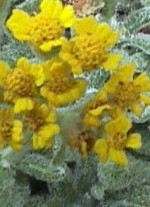T his semi-evergreen, mat-forming perennial is native to the lowlands of Europe and western Asia and is a member of the aster family, Asteraceae, that also includes daisy, goldenrod and lettuce. It grows to 6-12” tall and has a spreading habit and woolly fern-like foliage that is linear-lanceolate, twice pinnately divided, and fragrance when bruised. From late spring to early autumn flowerheads 1/8” across appear in dense flat-topped clusters up to 2” across and consist of yellow disc flowers surrounded by bright yellow ray flowers. The flowers are good in fresh and dried arrangements and the plants are a good choice for a rock garden, wall garden, cutting garden, edging and ground cover. Although it does well most well-drained soils it does not tolerate heat and humidity so may deteriorate in the South. The genus name, Achillea, honors the Greek warrior of the Trojan was, Achilles, who is said to have used one of a plants in the genus to heal the wounds of his soldiers. The specific epithet, tomentosa, is the Latin word meaning hairy and refers to the surface of the leaves.
his semi-evergreen, mat-forming perennial is native to the lowlands of Europe and western Asia and is a member of the aster family, Asteraceae, that also includes daisy, goldenrod and lettuce. It grows to 6-12” tall and has a spreading habit and woolly fern-like foliage that is linear-lanceolate, twice pinnately divided, and fragrance when bruised. From late spring to early autumn flowerheads 1/8” across appear in dense flat-topped clusters up to 2” across and consist of yellow disc flowers surrounded by bright yellow ray flowers. The flowers are good in fresh and dried arrangements and the plants are a good choice for a rock garden, wall garden, cutting garden, edging and ground cover. Although it does well most well-drained soils it does not tolerate heat and humidity so may deteriorate in the South. The genus name, Achillea, honors the Greek warrior of the Trojan was, Achilles, who is said to have used one of a plants in the genus to heal the wounds of his soldiers. The specific epithet, tomentosa, is the Latin word meaning hairy and refers to the surface of the leaves.
Type: Evergreen, herbaceous perennial
Bloom: Golden-yellow flowers in corymbs up to 2” across in early summer
Foliage: Deeply cut, light green, aromatic leaves 2” long and covered with hairs to give a woolly appearance.
Size: 6-12”H x 18” W
Light: Full sun
Soil: Lean, well-drained
Hardiness: Zones 3-7
Care: Deadhead to prolong bloom; divide every 3-4 years.
Pests and Diseases: Susceptible to stem not, powdery mildew and rust.
Propagation: Division, seed
Companion plants: Blue fescue, short leaf stonecrop, Erigeron compositus, “Silver Mound”
Outstanding Selections:
 var. aurea (golden yellow flowers on 3-8” stems)
var. aurea (golden yellow flowers on 3-8” stems)
 ‘King Edward VIII’ (pale yellow flowers on 10-12” stems)
‘King Edward VIII’ (pale yellow flowers on 10-12” stems)
